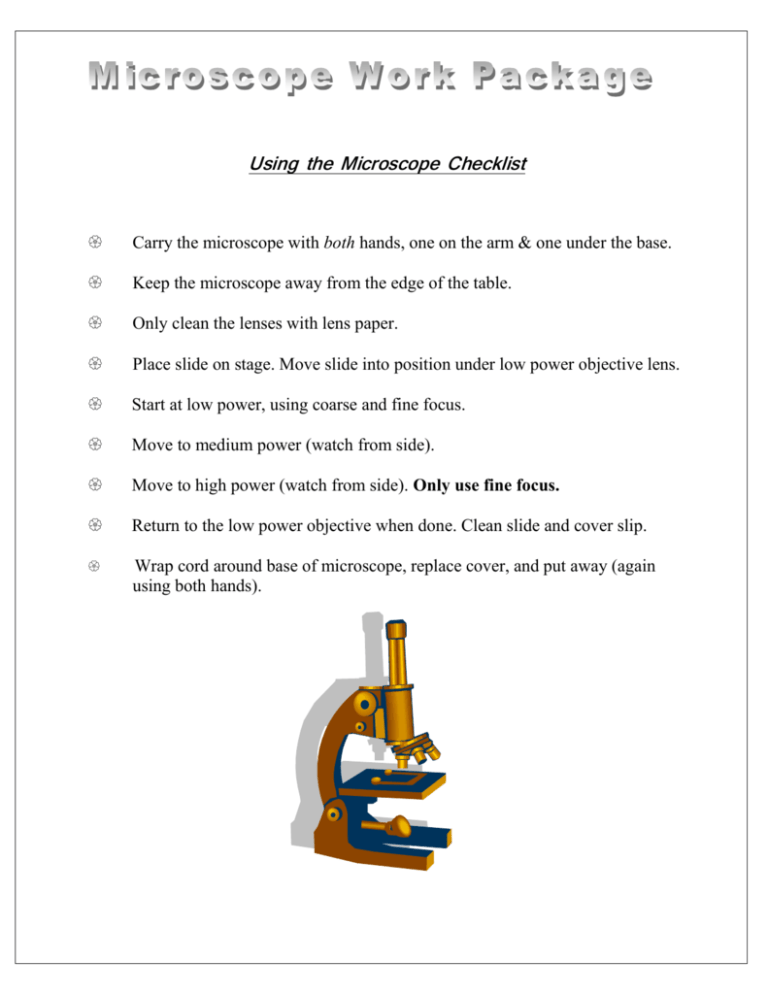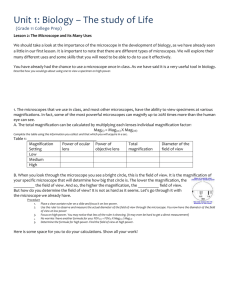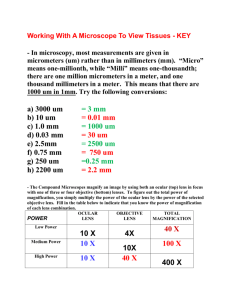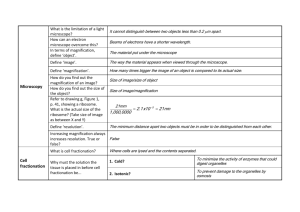Aspects of the microscope - Winston Knoll Collegiate
advertisement

Using the Microscope Checklist Carry the microscope with both hands, one on the arm & one under the base. Keep the microscope away from the edge of the table. Only clean the lenses with lens paper. Place slide on stage. Move slide into position under low power objective lens. Start at low power, using coarse and fine focus. Move to medium power (watch from side). Move to high power (watch from side). Only use fine focus. Return to the low power objective when done. Clean slide and cover slip. Wrap cord around base of microscope, replace cover, and put away (again using both hands). The Instrument The microscope has traditionally been the single most important tool for biologists. Before the development of this instrument, the microscopic world was hidden. Before the microscope scientists’ understanding of the nature of life at the cellular level was limited. Therefore, it is essential for every biology student to develop the skills involved in using the microscope. After completing this work package you will be able to… Label and state the function of each part of a compound microscope. Calculate the total magnification of a microscope. Calculate the diameter of the field of view and measure a specimen. Focus in on a specimen going from low-medium-high power. Prepare a wet mount slide for viewing under a microscope. Stain a biological specimen for viewing under a microscope. Your text contains information on use of microscopes in Appendix A: Pgs. 1070-1071 PART 1. COMPONENTS AND CARE OF THE COMPOUND MICROSCOPE a) Know and understand each step in the checklist on the previous page. b) Use your text book (pg. 1070) to label the parts of the microscope below. Do not label parts 7 and 14. Include a brief description of each part. -2- PART 2. USE OF THE COMPOUND MICROSCOPE Aspects of the microscope: Inversion: the image shown through a microscope is inverted, or flipped around in two directions. Magnification: the increase of an object's apparent size. Resolution: the power to show details clearly. Resolution allows the viewer to see two objects that are very close together as two objects rather than as one. Total Magnification: Compound microscopes use multiple lenses to produce an increase in magnification. Multiply the objective lens magnification by the eyepiece magnification (10X). E.g. If the eyepiece lens enlarges 10X and the objective lens enlarges 40X, the total magnification is 400X. Field of view (FOV): The area visible through the eyepiece. Field of view decreases as magnification increases. You must have your specimen in the centre of the FOV when you increase magnification. Diameter of Field of View: Because objects examined under a microscope are usually quite small, biologists find it convenient to use units called micrometers or microns (µm). The micron (µm) = 1/1000 of a mm. Place a plastic ruler (showing millimeters) on the stage. Using the low powered objective, obtain a well-defined image of the divisions of the ruler. Carefully move the ruler until its marked edge passes through the part of the of the field of view (across the centre of the FOV). Count the number of divisions (mm). This is the diameter of the FOV on low power in millimeters. Convert this to microns. (i.e. multiply by 1000). Divide this value by 2.5 to get the FOV diameter for medium power, and divide by 10 to get the FOV diameter for high power. Lens Measurement or Calculation of Diameter of FOV (mm) Low Power (4x) (measured) Medium Power (10x) (÷2.5) High Power (40x) (÷10) E.g. How large is the field of view for the microscope shown below? i) Find the FOV diameter for low power in mm and µm. ii) Calculate the FOV diameter for the high power in µm. -3- Diameter of Field of View (µm) Estimating sizes: To estimate the size of a specimen in the FOV, use the diameter of the FOV for the appropriate lens divided by the number of times that you estimate that the specimen would fit across the centre of the FOV. Estimated size of specimen= Diameter of FOV ÷ Number of times specimen fits across centre of FOV E.g. If the diameter of the FOV is 500 µm, what is the estimated size of the specimen? Estimate: -4- Name: Partner: Mic. #: Observation of Prepared Slides i) First, you must calculate the diameter of the FOV for your microscope at medium and high powers. Do that below. Show your work. ii) Obtain a prepared slide. Indicate which slide you have. Examine the slides under low, medium and high power. Draw what you see at each magnification. Estimate the size of a specimen on the high magnification view (show work). Make sure that you indicate which specimen you measured. Low Medium High Specimen 1: ___________ Size: ___________ Low Medium High Specimen 2: ___________ Size: ___________ Low Medium High Specimen 3: ___________ Size: ___________ -5- PART 3. PREPARATION OF SLIDES Preparing a wet mount: i. Obtain a clean slide and cover slip. Wipe with a damp towel and dry if it has water spots. ii. Put the specimen on the slide. iii. Place a drop or two of water on the specimen, if necessary. iv. Slide the cover slip at a 450 angle along the surface of the slide, then drop it to cover onto the specimen (like a hinge on a trapdoor). If adding stain, use the following technique called “wicking”: v. Add a little of the appropriate stain to one side of the cover slip. Touch a paper towel to the slide next to the cover slip on the opposite side of the stain. The towel will draw (wick) the water under the cover slip, pulling the stain under the cover slip thereby staining the specimen. WARNING: STAINS CAN NOT BE REMOVED FROM CLOTHING AND CAN BE TOXIC IF INGESTED. a) Practice creating a wet mount: Make a wet mount slide of the letter “e”. Answer the following questions. You only need to view the letter under low power. 1. In the space below, draw the letter “e” as it appears on the microscope stage with the naked eye and as it appears through the microscope’s FOV. 2. Move the slide to the right. Which way does the image appear to move? What happens when you move the slide to the left? 3. Move the slide away from you. Which way does the image appear to move? Which way does the image move when you move the slide towards yourself? 4. Give an example of each aspect of the microscope that you notice with the letter “e”. Inversion Magnification Resolution -6- b) Staining Animal Cells 1. Use a toothpick to scrape the inside of your cheek and prepare a wet-mount slide of the epithelial cells. Use methylene blue stain to stain the sample. View the cells on low power (4x) and medium power (10x). Draw a few individual epithelial cells. Indicate the various shapes, sizes, and any visible details. Mag.: __________ Mag.: __________ Mag.: __________ Size: ___________ Size: ___________ Size: ___________ c) Staining Plant Cells 1. Prepare a wet-mount slide of a thin layer of onion. Use methylene blue stain to stain the sample. View the onion cells on low power (4x) and medium power (10x). Draw a few individual onion cells. Indicate the various shapes, sizes, and any visible details. Mag.: __________ Mag.: __________ Mag.: __________ Size: ___________ Size: ___________ Size: ___________ -7- d) Staining Yeast Cells Make a slide of the yeast suspension (you will not have to add additional water). Use methylene blue to stain the sample. Draw a few individual yeast cells. Indicate the various shapes, sizes, and any visible details. Are any of them “budding” (reproducing asexually)? It will look like a small cell is growing out of a larger one. Mag.: __________ Mag.: __________ Mag.: __________ Size: ___________ Size: ___________ Size: ___________ e) Examine Some Pond Water Add a drop or two of pond water and cover with a cover slip. Use methylene blue stain to stain the sample. Examine the water under low, medium, and high power. Indicate the size and draw three examples of specimens that you see. You might have to chase them around – they might not stand still for you! Mag.: __________ Mag.: __________ Mag.: __________ Size: ___________ Size: ___________ Size: ___________ -8- QUESTIONS: 1. Which has a larger field of view – the low power or high power objective lens? 2. Which magnifies to a greater degree – the low power or high power objective lens? 3. Why is it important to have high resolution in a microscope? 4. Compare the sizes and shapes of the types of cells examined in Part 3 (i.e. animal, plant, yeast cells) 5. What accounts for the difference in shape between the plant cells and other types of cells? Refer to pg. 175. 6. Look at the cell parts on pg. 175 in your text. Did you see evidence of the nucleus in the cells you examined? 7. Use the image and information below to calculate i.) the total magnification on high power; ii) the diameter of the low power and high power FOVs in µm; iii) the size of any one of the cells in the HP FOV in the image below. Show all work. a) the eyepiece lens has a magnification of 5X b) the low power FOV diameter was measured to be 5.5 mm c) the low power objective lens is 4X magnification, the high power lens is 40X magnification -9-










